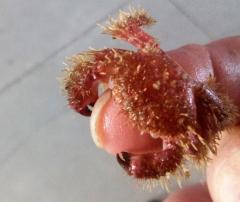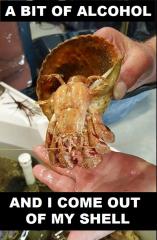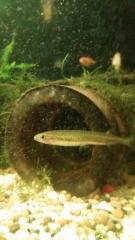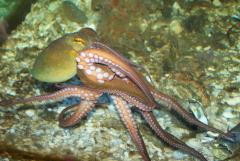-
Posts
17888 -
Joined
-
Last visited
Content Type
Profiles
Forums
Events
Plant Articles
Fish Articles & Guides
Clubs
Gallery
Everything posted by livingart
-
Have fed mine crushed flake, could try whiteworms also that is one hell of a powerboard
-
Yes all the gear i use at the University is tested and tagged each year, i use plugboards with individual switches for each outlet so i can just turn off one fitting at a time. All lights run off two big wall mounted timers.
-
Beautiful system, well done Which part of the legislation is your setup governed by?
-
Found this in the seahorse tank the other day .
-
I have put the photos in gallery on here then copied link into the post before if that helps. Strange with the chiller as a new motherboard should have fixed the problem, you could leave it plugged in while doing maintenance or run it on a bucket of water
-
A well thought out project, what issues are you having with the chiller and how did you go about loading a pic?
-
Sorry, this content isn't available at the moment The link you followed may have expired, or the Page may only be visible to an audience that you aren't in. Go back to the previous page · Go to News Feed · Visit our Help Centre
-
Breeding Maroon Clowns Breeding clownfish nowadays is a relatively easy thing to accomplish and not nearly as hard as you might think so long as some of the basics of fish keeping are adhered to. For the purposes of this write up I will assume you have already kept tropical marine and understand the needs to keeping the water parameters stable. My first foray into clownfish breeding occurred as I had a pair of maroon Clowns that laid in my reef tank, if you don’t already have a pair the other options are obviously to either purchase a known pair or buy 3 to 5 juveniles and grow them on. Buying an established pair is perhaps the easiest way to go as some local pet shops with a marine section either have these or can order them in for you, the other way is to buy a group of juveniles and raise them to breeding age. This can take up to 2 years with some species, with juveniles as the group grows they will pair up by themselves with the female being the largest and the male the next biggest while the rest should stay juveniles. If there is a selection of larger fish in the pet store look for a pair that swim together as this is a good sign that they are a true pair. In the wild in a group of Clownfish the female is the largest, with the male as the second largest. All others will be juveniles and gender-neutral. When one of the adults disappears, the next biggest will take its place. Thus the male will become female and a juvenile will turn into a male. Once they are female they cannot change sex again. For a breeding set-up the larger species like Maroon Clowns will need a 60 litre tank and the smaller species like Ocellaris a 45 litre tank, for filtration I use the air powered sponge filters that have been kept for at least 4 weeks in a mature system to allow the bacteria to populate them to aid in the nitrogen cycle. I put a small clay or ceramic pot in the tank for the pair to spawn on and of course a heater to maintain the tank at 25c. Lighting can be simple try to simulate daylight as much as possible, a timer for the light on your system is a must to allow the fish to get into a regular night to daytime cycle, I usually run 12 hours on and 12 off. Once you have your pair set up in their tank you will need a good dose of the marine keepers friend, Patience, while waiting for them to lay but feeding live foods like Mysid or Daphnia can help condition them. Don’t forget another dose of patience as well. A light on a timer -- regular day/night cycle is important. Once your pair is happy in their tank you need to get prepared to feeding the larvae as once they are free swimming they will need a constant supply of Rotifers, and to feed the rotifers you will need some phyto plankton. This takes some preparation but is achievable, Phyto plankton is essentially green water, usually in this country either Tetraselmis or nannochloropsis and rotifers are normally Brachionus sp.. I will do how I have set this up at the end of the article. If you get lucky your pair will spend a few days cleaning a spot on the surface of the pot then hopefully you will seesome bright orange eggs appear there, within a couple of days the color fades and eyes will start to appear. The male guards the nest and fans the eggs to keep them oxygenated clean, and at around 8 to 10 days, depending on the temperature, the eyes will become silver and will usually hatch that night. Usually I turn the lights and flow to the tank off then after ½ hr I shine a small led light into a corner of the tank, the fry are attracted to this and once enough are gathered there I scoop them out with a plastic container. I have used a net before but lost most of the fry to damaged fins and fungus. If you choose to move the rock and eggs to a separate tank prior to hatching you must keep the eggs aerated gently with a air stone or fungus can set in. For the Larvae tank a 7 to 10 litre tank with a small light, air stone and heater will suffice, I keep an eye on ammonia levels and have some ammolock handy if necessary. You may need to leave a light on the first few until the larvae develop their hunting skills. The first 10 days are the most crucial and I keep the levels of phyto and rotifers fairly dense in the tank so fry aren’t expending energy looking for food, and use a 5mm tube t clean floor of the tank and remove water for a 10% water change daily. . This is the period when the greatest numbers are lost. For some reason metamorphosis (around day 10) is very stressful. Immediately following this transition stage, the youngsters will begin developing their stripes... after which point you're pretty much home free.
-
Breeding Maroon Clowns Breeding clownfish nowadays is a relatively easy thing to accomplish and not nearly as hard as you might think so long as some of the basics of fish keeping are adhered to. For the purposes of this write up I will assume you have already kept tropical marine and understand the needs to keeping the water parameters stable. My first foray into clownfish breeding occurred as I had a pair of maroon Clowns that laid in my reef tank, if you don’t already have a pair the other options are obviously to either purchase a known pair or buy 3 to 5 juveniles and grow them on. Buying an established pair is perhaps the easiest way to go as some local pet shops with a marine section either have these or can order them in for you, the other way is to buy a group of juveniles and raise them to breeding age. This can take up to 2 years with some species, with juveniles as the group grows they will pair up by themselves with the female being the largest and the male the next biggest while the rest should stay juveniles. If there is a selection of larger fish in the pet store look for a pair that swim together as this is a good sign that they are a true pair. In the wild in a group of Clownfish the female is the largest, with the male as the second largest. All others will be juveniles and gender-neutral. When one of the adults disappears, the next biggest will take its place. Thus the male will become female and a juvenile will turn into a male. Once they are female they cannot change sex again. For a breeding set-up the larger species like Maroon Clowns will need a 60 litre tank and the smaller species like Ocellaris a 45 litre tank, for filtration I use the air powered sponge filters that have been kept for at least 4 weeks in a mature system to allow the bacteria to populate them to aid in the nitrogen cycle. I put a small clay or ceramic pot in the tank for the pair to spawn on and of course a heater to maintain the tank at 25c. Lighting can be simple try to simulate daylight as much as possible, a timer for the light on your system is a must to allow the fish to get into a regular night to daytime cycle, I usually run 12 hours on and 12 off. Once you have your pair set up in their tank you will need a good dose of the marine keepers friend, Patience, while waiting for them to lay but feeding live foods like Mysid or Daphnia can help condition them. Don’t forget another dose of patience as well. A light on a timer -- regular day/night cycle is important. Once your pair is happy in their tank you need to get prepared to feeding the larvae as once they are free swimming they will need a constant supply of Rotifers, and to feed the rotifers you will need some phyto plankton. This takes some preparation but is achievable, Phyto plankton is essentially green water, usually in this country either Tetraselmis or nannochloropsis and rotifers are normally Brachionus sp.. I will do how I have set this up at the end of the article. If you get lucky your pair will spend a few days cleaning a spot on the surface of the pot then hopefully you will seesome bright orange eggs appear there, within a couple of days the color fades and eyes will start to appear. The male guards the nest and fans the eggs to keep them oxygenated clean, and at around 8 to 10 days, depending on the temperature, the eyes will become silver and will usually hatch that night. Usually I turn the lights and flow to the tank off then after ½ hr I shine a small led light into a corner of the tank, the fry are attracted to this and once enough are gathered there I scoop them out with a plastic container. I have used a net before but lost most of the fry to damaged fins and fungus. If you choose to move the rock and eggs to a separate tank prior to hatching you must keep the eggs aerated gently with a air stone or fungus can set in. For the Larvae tank a 7 to 10 litre tank with a small light, air stone and heater will suffice, I keep an eye on ammonia levels and have some ammolock handy if necessary. You may need to leave a light on the first few until the larvae develop their hunting skills. The first 10 days are the most crucial and I keep the levels of phyto and rotifers fairly dense in the tank so fry aren’t expending energy looking for food, and use a 5mm tube t clean floor of the tank and remove water for a 10% water change daily. . This is the period when the greatest numbers are lost. For some reason metamorphosis (around day 10) is very stressful. Immediately following this transition stage, the youngsters will begin developing their stripes... after which point you're pretty much home free.
-
It was asking for submissions on the proposed draft for a new import standard, submissions have now closed.
-
Dealing with Algaes by Fishwise nz
-
-
Fish fight, well more like handbags at twenty paces. https://youtu.be/JrsPxbjxjD4
-
-

Our condolences to the family of Liam Slattery,
livingart posted a topic in FNZAS & Afflilated Clubs
Our condolences to the family of Liam Slattery, a past president of Dunedin Aquarium and Pond Society. He will be dearly missed by local club members and the general fish keeping community. Unfortunately he passed away on Wednesday, his funeral is at holy name church at 2pm on Monday 420 Great King St, North Dunedin, Dunedin 9016 -
-
Yes T5's are good, just don't buy an aquaone skimmer lol
-
90cm high is a lot of pressure on glass
-
http://www.landcareresearch.co.nz/resources/identification/animals/freshwater-invertebrates/guide/jointed-legs/crustaceans/shrimps/freshwater-shrimp
-
May need to cross your legs too lol Good luck









